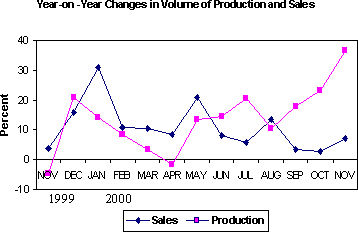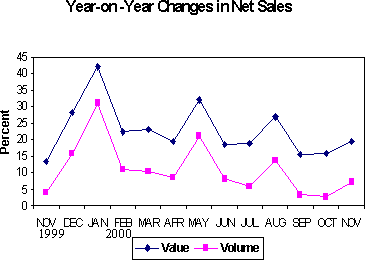- Comparative year-on-year production still up
Production output of the manufacturing industry in November 2000 moved up by 47.9 percent in value and 36.6 percent in volume compared to a year ago according to the preliminary results of the Monthly Integrated Survey of Selected Industries (MISSI).
Sectors that significantly contributed to the positive year-on-year performance of the manufacturing industry were electrical machinery (121.3%), petroleum refineries (26.8%) and wearing apparel (51.3%). The increases in the production of these sectors were mainly due to the increased demand in domestic and/or export markets. Electrical machinery also reported that an increased workforce contributed to their positive performance. Aside from the high seasonal demand for the products in the wearing apparel sector, the resumption of operations of some key establishments in this sector resulted in the increase of output.
This positive performance came about despite the decline in production in food manufacturing, textile and transport equipment.
Furthermore, the decrease of 4.6 percent in November 1999 may have caused a "base effect" on the comparative year-on-year performance in November 2000.
- While month-on-month production declines
Production output in November 2000 declined by 7.3 percent in value and 7.5 percent in volume compared to the output last month. The political crisis in the country which may have aggravated the lack of demand for products and triggered temporary or permanent shutdowns of some firms could have caused the unfavorable month-on-month performance of the manufacturing industry.
The poor performance of food manufacturing, petroleum refineries, transport equipment, basic metals and textile sectors resulted to the negative month-on-month growth in manufacturing.
- Net sales rise but slower than production
Net sales improved as the value and volume expanded by 19.4 percent and 7.2 percent from a year ago, respectively. The growth in value of net sales was 3.6 percentage point higher than the growth posted in October 2000 while volume of net sales growth was 4.5 percentage points higher than the growth last month.
Petroleum products was the top gainer in terms of value escalating by 54.9 percent while electrical machinery, particularly microcircuits, led in terms of volume with 36.9 percent growth from a year ago. On the other hand, the largest declines in value and volume of net sales were in food manufacturing.
There were indications of some inventory replenishment and/or build-up in some sectors as the overall production volume growth of 36.6 percent surpassed the net sales volume growth posted at 7.2 percent by 5 times.

- Producer prices up but slower
Producer price index (PPI) rose by 8.3 percent to 154.2 in November 2000 from 142.4 in November 1999. The year-on-year increase in November 2000 PPI was slower compared to the 8.8 percent posted in October 2000 but higher than the 6.5 percent increment in November 1999.
The upward trend in the prices of petroleum product (43.0%), fabricated metal products (25.5%), textile (25.0%), printing & publishing (20.5%), and electrical machinery (16.8%) had a substantial impact on the gain in the overall PPI.
Increases in the producer prices could be attributed to higher cost of production inputs particularly of oil and other imported inputs aggravated by the weakening of peso.
- Average Capacity Utilization at 80.2%
Average capacity utilization rate for November 2000 for manufacturing was estimated at 80.2 percent, lower by 3.8 percentage points from the 84.0 percent posted in October 2000. However, this rate marked a 1.6 percentage point improvement over the 78.6 percent recorded in November 1999. Nine out 16 sectors improved capacity utilization as compared to the same month last year. Electrical machinery had the highest capacity utilization rate of 92.0 percent while transport equipment posted the lowest capacity utilization rate of 63.4 percent.
- Value of Production
In November 2000, the value of production index (VaPI) of 680.7 increased by 47.9 percent from 460.1 in November 1999. Year-on year increases were observed in 9 out of 16 major sectors led by electrical machinery, which increased by 158.5 percent (See Annex 1-A). Other sectors contributing double-digit growths to the value of production were petroleum refineries (81.4%), wearing apparel (36.7%), paper & paper products (27.3%), non-metallic minerals (13.5%) and furniture & fixtures (10.0%).
On the other hand, losers in terms of value of production were food manufacturing (-14.03%), transport equipment (-22.9%), textile (-13.9%), wood & wood products (-19.4%), chemicals (-6.0%), rubber products (-11.8%) and beverage (-2.0%).

- Volume of Production
The volume of production index (VoPI) increased by 36.6 percent to 171.8 from 125.8 of the same month last year. Nine out of 16 sectors posted year-on-year increases led by electrical machinery with 121.3 percent increment. (See Annex 1-B). Other sectors which exhibited double-digit growths over their performance a year ago were petroleum refineries (26.8%), wearing apparel (51.3%), paper & paper products (30.3%), basic metals (13.2%), non-metallic minerals (11.7%), miscellaneous manufactures (13.4%), and furniture & fixtures (10.0%). The increases in the production of these sectors can be attributed to the increased demand for the products in both domestic and export markets. Electrical machinery also reported increases in labor inputs while paper & paper products attributed its positive growth in the improvement in machine performance. The resumption of operations of some key establishments in non-metallic minerals, wearing apparel and basic metals contributed largely to the positive performance of these sectors.
Losers in terms of volume of production were food manufacturing (-14.3%), textile (-31.1%), transport equipment (-24.9%), chemicals (-9.8%), wood & wood products (-19.4%), beverage (-9.5%) and rubber products (-11.7%). The slowdown in production in some of these sectors can be attributed to low demand, lack of raw materials, and labor problems which resulted to closure of some plants and partial/temporary shutdown of machinery.
On a month-on-month basis, the overall production performance in terms of production volume declined by 7.5 percent. Eleven out 16 sectors contributed to the overall decline in the volume of production led by food manufacturingwith 32.9 percent decrement. Other sectors which exhibited double-digit negative growths were petroleum refineries (-10.3%), transport equipment (-29.6%), basic metals (-15.5%), textile (-19.9%), beverage (-14.5%), rubber products (-15.8%), furniture & fixtures (-10.9%) and other manufacturing industries (-12.1%).
- Value of Net Sales
The value of net sales for November 2000 moved up by 19.4 percent compared to the same month last year. Eleven out of 16 major sectors showed improvements in their value of net sales. The leading sector was petroleum refineries which rose by 54.9 percent over the same month last year (See Annex 2-A). Other sectors that exhibited double-digit year-on-year growths in their value of net sales were electrical machinery (59.9%), wearing apparel (39.6%), paper & paper products (22.0%), non-metallic minerals (16.2%), miscellaneous manufacture (12.3%) and tobacco (23.9%).
On the other hand, sectors with lower values of net sales as compared to the same month last year were food manufacturing (-4.9%), transport equipment (-21.1%), wood & wood products (-21.4%), basic metals (-3.3%) and rubber products(-0.4%).

- Volume of Net Sales
The volume of net sales for November 2000 increased by 7.2 percent over the same month last year. Increases were observed in 10 out of 16 sectors led by electrical machinery which expanded by 36.9 percent (See Annex 2-B). Other sectors that exhibited double-digit growths were wearing apparel (54.9%), paper & paper products (24.9%), non-metallic minerals (16.4%), miscellaneous manufactures (19.7%) and tobacco(25.2%). On the other hand, double-digit decreases were observed in transport equipment (-23.1%), textile (-16.3.1%), and wood & wood products (-21.4%).
On a monthly basis, the volume of net sales decreased by 5.1 percent. Fourteen out of 16 sectors contributed to the decrease, led by basic metals which declined by 22.6 percent. Other sectors that exhibited double-digit decreases were transport equipment (-24.8%), beverage (-15.9%), rubber products (-12.6%) and miscellaneous manufactures (-12.2%).
- Capacity Utilization
The proportion of responding establishments that operated at full capacity (90%-100%) in November 2000 was 20.5 percent, higher by 2.5 percentage points from 18.0 percent in November 1999 (See Annex 3-A). About 37.9 percent operated below the 70 percent capacity utilization. This was lower by 0.9 percentage point from 38.8 percent in November 1999.
The November 2000 average capacity utilization rate for manufacturing was estimated at 80.2 percent, up by 1.6 percentage points over the same month last year (See Annex 3B). However, this rate was lower by 3.8. percentage points to the 84.0 percent recorded in October 2000.
Of the 16 sectors, 9 sectors posted higher capacity utilization rates as compared to a year ago. Leading sector was electrical machinery which recorded an average capacity utilization rate of 92.0 percent. Other sectors which registered more than 80 percent capacity utilization rates were tobacco (84.2%), wearing apparel (84.0%), furniture & fixtures (85.1%), paper & paper products (84.4%), chemicals (82.2%), petroleum refineries (89.7%) and miscellaneous manufactures (84.5%).
- Response Rate
These results were based on the response of 344 sample establishments, which comprised 66.2 percent of the total number of establishments covered by the survey.







Source: National Statistics Office
Manila, Philippines
